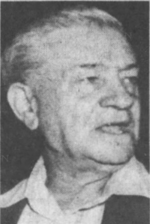 AP Sentenced to a prison term of 15 to 30 years in 1933 for first-degree manslaughter in the death of his friend in a Harlem, New York, speakeasy brawl, William Fisher was released eleven years later. He then spent 14 more years seeking to overturn his conviction before being exonerated in 1958 and ultimately obtaining compensation for wrongful conviction in 1986. William Fisher, age 22 at the time, testified at trial that he was having a drink in a Harlem club on the night of January 28, 1933, when he was assaulted and stabbed by several men. According to witness statements withheld from the defense, including a statement from a uniformed police officer, Fisher was already outside the nightclub suffering from multiple stab wounds when shots were fired inside the club, killing two men. One of these victims was Daniel Feldman, a friend of Fisher. Fisher was indicted by a grand jury for the shooting death of Feldman, and he was brought to trial in October 1933. The prosecution’s theory was that Fisher and another man, Hugh Mulligan, had engaged in a gun-battle across the front room of the club, with a shot aimed by Fisher at Mulligan instead hitting and killing Feldman, who had been standing near Mulligan. The prosecutor, Assistant District Attorney Miles O’Brian, introduced into evidence, over defense objections, a gun he claimed to be the weapon Fisher used to shoot Feldman. Despite the fact that Mr. O’Brian knew and later admitted that the weapon was not and could not have been the weapon that killed Feldman, he suppressed evidence to that effect. The prosecutor also concealed, from the jury and the defense, evidence that (i) at least three people fired guns at the club on the night in question, contradicting the prosecution’s theory and corroborating the defense’s contention that several holdup men had shot a number of individuals in the club, including Feldman; (ii) several witnesses, including a uniformed police officer, had placed Fisher injured and lying outside the club on a sidewalk when shots were fired within the club; and (iii) a witness had stated that the club was held up by several men with guns and that these men had fired the shots which killed Feldman. In October 1934, while in prison, Fisher wrote to the judge who had presided over his trial to request a new trial based on evidence he had learned while in prison establishing that the gun introduced as the murder weapon at trial could not have been the gun that killed Feldman. However, as a result of inaction by certain agencies, and later by the judge’s death and accompanying lapses in communication, Fisher’s attempts to gain a new trial were unsuccessful. In 1944, Fisher was released from prison, and during his subsequent 14-year parole and thereafter, he continued to assert his innocence and make court filings to have his conviction overturned or to obtain a new trial. Finally, in 1958, following a factual hearing ordered by the Court of Appeals of New York, the Court of General Sessions vacated Fisher’s conviction and dismissed the 1933 indictment against him. Following the overturning of his conviction, Fisher sought restitution for wrongful conviction through the state and federal courts, but was unsuccessful on various technical grounds. In addition, legislative efforts were made on behalf of Fisher. Between 1959 and 1983, six bills were passed by the New York Legislature to confer jurisdiction on the New York Courts to hear Fisher’s claims against the State and City of New York. However, each of these bills was vetoed by the governor in office at the time. Finally, a seventh bill conferring such jurisdiction was passed by the New York Legislature in 1984 and signed by Governor Mario Cuomo. In 1986, the New York State Court of Claims awarded William Fisher, age 74 years old, $750,000 for his wrongful conviction. - Craig Andrews
|